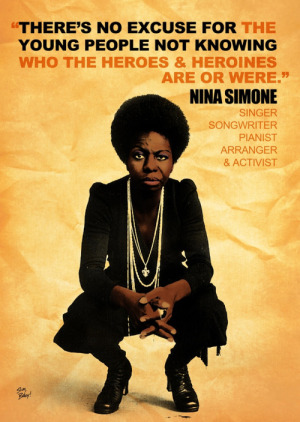INQUIRER: It’s one of those stories that has lodged in the minds of many for its injustice and irony. Nina Simone – before she was Nina Simone, when she was still an aspiring classical pianist named Eunice Waymon – auditioned for the Curtis Institute of Music and was rejected on grounds of her race. The tale bubbles up every few years, refracted through the times, as it is doing again in our era of Ferguson and Sandra Bland. Simone herself recounted the story repeatedly during her lifetime. “I was rejected because I was black,” she told The Inquirer in 1993, adding with some relish that, since then, her name had grown “bigger than the whole Curtis Institute.”
Indeed. The Curtis rejection, painful as it was, became a catalyst. It caused Eunice Waymon to find her voice, literally and figuratively, and to become Nina Simone. Most recently, the Curtis story was relayed in a Netflix documentary, What Happened, Miss Simone? by Liz Garbus, where it jars and stings. Institutional racism of the 1950s went largely unchecked, and, intuitively, it makes sense that Curtis – elite, Old World, classical – was just one more whites-only club doing what whites-only clubs did. Another Nina Simone documentary, a biopic, and a biography are on the way, raising the likelihood that Curtis’ cameos are not over.
Certainly, racism exists as a spectrum – overt, cloaked, unconscious, internalized – and no one can know what motivated the Curtis piano faculty to listen to what must have been an extremely compelling audition on April 7, 1951, and then turn away one of the 20th century’s major musical figures. But the truth is more likely something far more common and less interesting: MORE
RELATED: The Curtis Institute of Music is a conservatory in Philadelphia that offers courses of study leading to a performance diploma, Bachelor of Music, Master of Music in Opera, or Professional Studies Certificate in Opera. It is renowned for being the most selective higher learning institution in the United States, with a 3.2% admissions rate. MORE
ASSOCIATED PRESS: The distributor of the forthcoming film about Nina Simone says complaints about Zoe Saldana playing the singer reflect an interracial “pathology” established by slave owners. “It’s a tragic past that still exists today,” said Robert L. Johnson, head of the studio releasing “Nina” next month. Producers have been criticized since Saldana was cast in 2012 for choosing an actress who needed extensive makeup and prosthetics to achieve Simone’s dark skin and traditionally African features.
“What people are expressing today is something that happened to us during slavery, when light-skinned blacks were turned against dark-skinned blacks and dark-skinned blacks were turned against light-skinned blacks,” Johnson told The Associated Press in an interview Wednesday. “It’s been an unfortunate part of our DNA that was put in our heads by slave masters that is still present today, as you see by people talking about is somebody dark enough to play a role.” MORE
THE ATLANTIC: Simone was able to conjure glamour in spite of everything the world said about black women who looked like her. And for that she enjoyed a special place in the pantheon of resistance. That fact doesn’t just have to do with her lyrics or her musicianship, but also how she looked. Simone is something more than a female Bob Marley. It is not simply the voice: It is the world that made that voice, all the hurt and pain of denigration, forged into something otherworldly. That voice, inevitably, calls us to look at Nina Simone’s face, and for a brief moment, understand that the hate we felt, that the mockery we dispensed, was unnatural, was the fruit of conjurations and the shadow of plunder. We look at Nina Simone’s face and the lie is exposed and we are shamed. We look at Nina Simone’s face and a terrible truth comes into view—there was nothing wrong with her. But there is something deeply wrong with us. MORE

